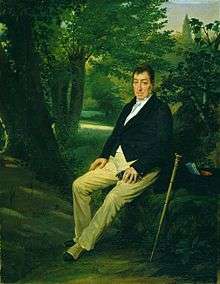Louise-Adéone Drölling
Louise-Adéone Drölling, also known as Madame Joubert (29 May 1797 - before 30 April 1836) was a French painter and draughtswoman. Both her father, Martin Drolling, and her older brother, Michel Martin Drolling, were celebrated artists in their day.[1][2]
Louise-Adéone Drölling | |
|---|---|
.jpg) Portrait of Louise-Adéone Drölling by her father, Martin Drolling (detail), 1812 | |
| Born | 29 May 1797 |
| Died | 1836 |
| Nationality | French |
| Other names | Madame Joubert |
| Occupation | French painter |
| Parent(s) |
|
| Relatives | Michel Martin Drolling (brother) |
Biography
Louise-Adéone Drölling was born 29 May 1797. At about age 10, she modeled for her father for the small Portrait of the Artist's Daughter (Musée Magnin, Dijon),[3] and later, at about age 15, for the life-sized Portrait of Adéone (Musée des Beaux-Arts, Strasbourg). Around this time, she was encouraged by her father to begin a career in painting.[4]
In 1819, Louise-Adéone married the architect Jean-Nicolas Pagnierre. She became a widow in 1822 and remarried four years later, in 1826. With her second husband, chief tax officer (octroi) of the city of Paris, Nicholas Roch Joubert (son of politician and former bishop Pierre-Mathieu Joubert), she had two daughters, Adéone Louise Sophie, and Angélique Marie.[2]
In 1827 and 1831[4] Louise-Adéone's paintings were exhibited in the Salon des Amis des Arts. For one of her works, Interior with Young Woman Tracing a Flower, she received a gold medal and the work was displayed at the Gallery of La Duchesse de Berry. Her date of death was for a long time uncertain and thought to be either 1831 (the year of her last recorded artistic activity), or 1834; but as it turned out, the list of her belongings after her death (inventaire après décès) was made on 30 April 1836, meaning that she had died shortly before that date.[5][6][2]
Characteristics
Drölling was not a prolific artist, as she admitted herself in a letter from 1828; the inventory after her death mentions only a dozen of works. Having been taught by her father (who had also been the teacher of her brother), she practiced a highly skillful but very traditional art; thus, some of her paintings and drawings have been attributed to either of both men, and vice-versa. In addition to the two portraits he painted of her, Martin Drolling used Louise-Adéone's recognizable, brown-haired and blue-eyed features in several of his later paintings.[2] Conversely, no self-portrait of Drölling has as yet been identified.
Gallery
 Interior with Young Woman Tracing a Flower, c. 1820-22, Saint Louis Art Museum, Saint Louis, Missouri
Interior with Young Woman Tracing a Flower, c. 1820-22, Saint Louis Art Museum, Saint Louis, Missouri Portrait of a child in a room, before 1831
Portrait of a child in a room, before 1831 Lafayette in the Park of Château de la Grange-Bléneau, 1830, Musée de l'armée, Paris
Lafayette in the Park of Château de la Grange-Bléneau, 1830, Musée de l'armée, Paris Martin Drolling: Portrait of the Artist's Daughter (1807 or slightly before)
Martin Drolling: Portrait of the Artist's Daughter (1807 or slightly before) Martin Drolling, Young Woman helping a poor Family, 1814, Musée des Beaux-Arts de Caen. Louise-Adéone (aged 16-17) as the young woman.
Martin Drolling, Young Woman helping a poor Family, 1814, Musée des Beaux-Arts de Caen. Louise-Adéone (aged 16-17) as the young woman.
References
| Wikimedia Commons has media related to Louise-Adéone Drölling. |
- "Ontdek schilder, kunstenaarsdochter Louise Adéone Drölling". rkd.nl (in Dutch). Retrieved 2020-06-27.
- Siffer, Florian (2013). "Récentes découvertes de dessins de Louise-Adéone Drölling (1797-1836) dans les collections du Cabinet des Estampes et des Dessins de Strasbourg". Cahiers Alsaciens d'Archéologie d'Art et d'Histoire. Retrieved 27 June 2020.
- "Portrait de la fille de l'artiste". French Ministry of Culture. Retrieved 27 June 2020.
- Levrat, Laetitia (2010). Martin Drölling (Bergheim 1752-Paris 1817) : un état de la question (PDF). Art et histoire de l’art. pp. 40, 41.
- Rewald, Sabine (2011). Rooms with a View: The Open Window in the 19th Century. New York: Metropolitan Museum of Art. p. 90. ISBN 1588394131.
- Nécrologe universel du dix-neuvième siècle (1851). Le Nécrologe universel du xixe siècle, par une société de gens de lettres [&c.] sous la direction de E. Saint-Maurice Cabany, Volume 6. E de Saint-Maurice-Cabany. p. 298.